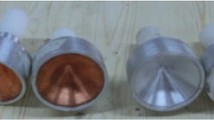Abstract
Shaped charges are used widely to penetrate into targets. The destruction level of them is measured by the depth of penetration profile and the diameter of the penetration profile crater. Changing the liner or duplicate its materials affects the rate of destruction (destruction level). It was reported that copper liner results in greater penetration profile depth and aluminum liner results in a larger crater diameter. In this research, first, the penetration profile of a copper liner shaped charge is theoretically and numerically analyzed using Autodyn software and compared to experimental ones which shows an acceptable agreement. Then, using the same process, the numerical solution of aluminum, nickel and bimetallic copper–aluminum and copper–nickel liners is performed. Comparing the experimental and numerical results, it can be calculated that the copper–aluminum liners have a good and proper penetration profile depth and crater diameter. The results are presented, discussed and commented upon.













Similar content being viewed by others
References
Galvani AH (1951) Theory and application of shaped charges. Ph.D. thesis, Bethlehem, Pennsylvania: Lehigh University
Walters WP, Zukas JA (1989) Fundamentals of shaped charges. Wiley, Hoboken
Gerami ND, Liaghat GH, Moghadas GHRS, Khazraiyan N (2017) Analysis of liner effect on shaped charge penetration profile into thick concrete targets. J Braz Soc Mech Sci Eng 39(8):3189–3201
Rollins RR, Clark GB, Kalia HN (1971) Penetration profile in granite by shaped charge liners of various metals. Missouri Univ-Rolla Rock Mechanics and Explosives Research Center
Dashtian GN, Liaghat G, Rahimi SMG, Khazraeyan N (2016) Investigation of performance of anti structure tandem projectiles into the concrete targets by experimental and numerical method. J Modares Mech Eng 16(10):9–18 (in Persian)
Wang C, Xu W, Li T (2017) Experimental and numerical studies on penetration profile of shaped charge into concrete and pebble layered targets. Int J Multiphys 11(3):295–313
Zhang X, Wu C, Huang F (2010) Penetration profile of shaped charge jets with tungsten–copper and copper liners at the same explosive-to-liner mass ratio into water. Shock Waves 20(3):263–267
Saran S, Ayısıt O, Yavuz MS (2013) Experimental investigations on aluminum shaped charge liners. Proc Eng 58:479–486
Kamarudin KH, Zaidi AMA, Abdullah S, Koslan MFS (2015) Establishment of shaped charge optimum parameters for small scale hydrodynamic penetration profile. Mod Appl Sci 10(1):82
Mahdian A, Liaghat GH, Ghayour M (2013) Generalized closed-form model for analysis of asymmetric shaped charges. J Appl Mech Tech Phys 54(2):259–267
Tie-Fu W, He-Rong Z (1996) Copper–tungsten shaped charge liner and its jet. Propellants Explos Pyrotech 21(4):193–195
Mason JS (2010) Experimental testing of bimetallic and reactive shaped charge liners. M.Sc. degree, University of Illinois, Urbana-Champaign
Xiao QQ, Huang ZX, Zu XD, Zhu CS (2013) Penetration profile research of jacketed jet into concrete. Int J Impact Eng 54:246–253
Dong W-J, Liu J-X, Cheng X-W, Li S-K, Zou Q-H, Guo W-Q (2016) Penetration profile performance of W/Cu double-layer shaped charge liners. Rare Met 35(2):184–191
Hasenberg D (2010) Consequences of coaxial jet penetration profile performance and shaped charge design criteria. B.Sc. degree, Naval Postgraduate School
Zhang X, Qiao L (2011) Studies on jet formation and penetration profile for a double-layer shaped charge. Combust Explos Shock Waves 47(2):241
Schilling TJ (2007) Reactive-injecting follow-through shaped charges from sequent-material conical liners. Propellants Explos Pyrotech 32(4):307–313
Yu Z, Wen-jin Y (2009) Effects of materials on formation of double-layered liners shaped charges. In: The 2nd international conference on multifunctional materials and structures was held in Qingdao, pp 1277–1280
Pugh EM, Eichelberger RJ, Rostoker N (1952) Theory of jet formation by charges with lined conical cavities. J Appl Phys 23(5):532–536
Rosenberg Z, Marmor E, Mayseless M (1990) On the hydrodynamic theory of long-rod penetration profile. Int J Impact Eng 10(1–4):483–486
Bolstad J, Mandell D (1992) Calculation of a shaped charge jet (king MESA-2D and MESA-3D hydrodynamic computer codes
Walters WP, Golaski SK (1987) Hemispherical and conical shaped-charge liner collapse and jet formation. Army Ballistic Research Lab Aberdeen Proving Ground MD
Matrosov AD, Shyetsov GA (1996) Experimental investigation of current instability of shaped-charge jets. J Appl Mech Tech Phys 37(4):464–469
Walsh JM, Shreffler RG, Willig FJ (1953) Limiting conditions for jet formation in high velocity collisions. J Appl Phys 24(3):349–359
Author information
Authors and Affiliations
Corresponding author
Additional information
Technical Editor: Paulo de Tarso Rocha de Mendonça, Ph.D.
Publisher's Note
Springer Nature remains neutral with regard to jurisdictional claims in published maps and institutional affiliations.
Rights and permissions
About this article
Cite this article
Mehmannavaz, H., Liaghat, G., Rahmati, S. et al. Theoretical, numerical and experimental analysis of bimetallic Cu–Al shaped charge’s liners and its influence on the penetration depth and the crater diameter of steel targets. J Braz. Soc. Mech. Sci. Eng. 41, 336 (2019). https://doi.org/10.1007/s40430-019-1828-2
Received:
Accepted:
Published:
DOI: https://doi.org/10.1007/s40430-019-1828-2




